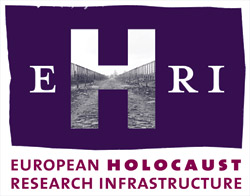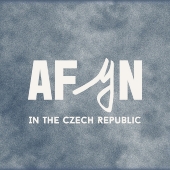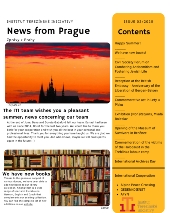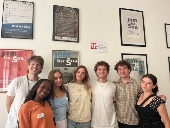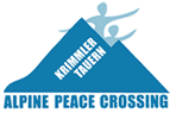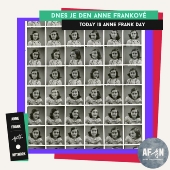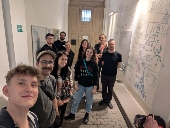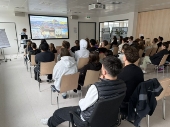Forced Labor
Expansion of Forced Labor
From the start, forced labor was a fundamental part of prisoner life in the concentration camps. While, after Hitlers rise to power, in the initial construction period of the concentration camps, they were mainly used to "correct", punish and spread terror, from 1937 economic aspects increasingly came into the picture and inmates were initially used in SS-owned businesses as slave laborers.
The territory of the Czech Republic was considered fairly safe from bombings during the Nazi regime. Especially in the final stages of World War II, this lead the concentration camps of Auschwitz, Flossenbürg (eastern Bavaria) und Groß-Rosen (Lower Silesia) to establish an extensive system of subcamps for armament production in the Sudetengau, the border areas which had been annexed by the German "Reich" in 1938, and in the Protectorate Bohemia and Moravia.
These subcamps were first established in armament factories which set up shop in the vicinity of the main camps. Another use the prisoner labor was put to until 1941/42 was in the "Baukommandos", the construction units. The first subcamp on Czech territory was opened in August 1942 to prepare for the exploitation of a mineral water spring for the SS-owned bottling company "Sudetenquell GmbH" in the West Bohemian town of Korunní.
Subcamps of KZ Flossenbürg

Map: KZ-Gedenkstätte Flossenbürg (Memorial Flossenbürg)
In 1942 the SS improved the organisational conditions of the concentration camp labor program by centralizing the various administrative tasks in the newly created "Wirtschafts- und Verwaltungshauptamt" (SS-WVHA, Economic and Administrative Head Office). The forced laborers were to be lent to private companies. Corporations could register requests for prisoners to the SS-WVHA and in case of a positive decision, the relevant concentration camp was instructed to erect a subcamp and organize guards. In other cases, prisoners were offered to companies by state authorities. Companies would pay a fee to the SS, according to gender and "qualifications" of the prisoner, and arrange for accommodation and provisions for prisoners and their guards.
Starting in mid 1944 and within a few months, the network of subcamps was expanded massively over the entire territory occupied by the "Reich". While in April of 1944 there had been 20 main camps and 130 subcamps for the state and private economies, the number of theses subcamps had increased to about 1000 by the end of the war. 90 percent of the 40 camps on the territory of the Czech Republic in existence by the end of the war had been built in the last year of the war. Partly, these camps were set up in places of existing camps structures, such as the "Schmelt" camps (non-KZ Jewish slave labor) in the Giant Mountains, which were partly incorporated into the Groß-Rosen camp network. The majority of subcamps set up in Czech lands in 1944 were female camps.
Apart from companies from the "Altreich" (Germany in its pre-1938 borders), such as AEG, Auto-Union, Dynamit Nobel, Siemens, Telefunken and their subsidiaries, who moved production to the Sudetengau and the "Protectorate of Bohemia and Moravia", local companies also made bids for armament contracts and the allocation of subcamps to their production facilities. Especially the north Bohemian textile manufacturing businesses, who were already "experienced" with the use of Jewish forced laborers, employed prisoners from Groß-Rosen on a grand scale. The SS employed prisoners, from Auschwitz and Flossenbürg, in their own companies, the porcelain factory "Bohemia" in Nová Role, or the north Moravian "Freudenthaler Getränke GmbH".
The majority of these subcamps were situated in the "Sudetenland" border areas. Only few foreign workers and concentration camp prisoners were deployed to the protectorate, due to misgivings of Karl Hermann Frank, state minister for Bohemia and Moravia. Though the SS was able to establish four smaller construction camp detachments since the end of 1943, these were sent to work on the SS proving ground "Beneschau" in Hradištko (German: Hradischko) and Vrchotovy Janovice (Janowitz) south of Prague and some smaller camps in Panenské Břežany (Jungfernbreschan) and Brno (Brünn).
Subcamps of KZ Gross-Rosen

| 4. Bernsdorf (Bernartice) | 54. Mährisch Weißwasser (Bilá Voda) |
| 14. Brünnlitz (Brněnec) | 57. Morchenstern (Smržovka) |
| 23. Gablonz (Jablonec nad Nisou) | 62. Ober Altstadt (Hořejší Staré Město) |
| 24. Gabersdorf (Libeč) | 63. Ober Hohenelbe (Hořejší Vrchlabí) |
| 33. Grulich (Králíky) | 64. Parschnitz (Poříčí) |
| 37. Halbstadt (Meziměstí) | 68. Reichenau (Rychnov u Jablonce nad Nisou) |
| 45. Kratzau I (Chrastava) | 72. Schatzler (Žacléř) |
| 46. Kratzau II (Chrastava) | 75. Sankt Georgenthal (Jiřetín) |
Project objectives
The 21 Flossenbürg, 18 Groß-Rosen and three Auschwitz subcamps on the territory of the Czech Republic known to historians, are today widely forgotten. This project intends to include completely distinct places of KZ forced labor into one research undertaking. One cannot compare the Kommando of 15 Jehovah's Witnesses who were deployed in the private household of Reinhard Heydrich's widow in Panenské Břežany (Jungfernbreschan), received sufficient rations and all survived the war to those in the "Knochenmühle" ("bone mill") in Litoměřice (Leitmeritz). There, in the relocation underground of the production facilities of Auto-Union and Osram, due to an insufficient diet, catastrophic sanitation, disease, work accidents and excessive violence from the guards, thousands of prisoners died.
Apart from the basic questions about some subcamps that have thus far not been answered, we also propose to closely define the role of the economic as well as the governmental entities who collaborated in the, sometimes linear, sometimes parallel, construction of the system of labor camps for concentration camp prisoners and other forced laborers. Special emphasis shall be put on conditions in the concentration camp subcamps and the working conditions for concentration camp prisoners, as well as for non-KZ forced laborers often employed in the same places.
Three weeks have already passed since the International Youth Forum started in South Carolina, hosted by the Anne Frank Center at the University of South Carolina (USC). Our very own Ani from Afyn.cz was one of the delegates. She has shared her reflections on the experience, what she learnt, and what she will take away from it. Read her report to get a glimpse of the IYF 2025!
It's the middle of summer, and we're bringing you the latest issue of our newsletter, News from Prague. We wish you a wonderful rest of your vacation and enjoyable reading.
This week, a group of students from the US (some with Czech family ties) has visited us as part of their summer school in the Czech Republic organised by the Mestenhauser Institute for International Collaboration (MIIC).
Our GEDENKDIENST-Volunteer Laurenz joined the Alpine Peace Crossing (APC) in Krimml to cross the Austrian Alps in remembrance of the thousands of Jews who fled the antisemitism that was still rampant in Europe after 1945. Laurenz welcomed the team to Jachymka a few weeks ago.
Yesterday we celebrated Anne Frank's legacy in a creative way by showcasing the artworks submitted by talented contributors at Žižcafé Therapy.
On Saturday our GEDENKDIENST volunteer Laurenz welcomed the team of the Alpine Peace Crossing to Jachymka to show them our work.
Alpine Peace Crossing (APC) is an Austrian organization based in Krimml (Salzburg province).
Our Volunteer Laurenz was in Austria last week to promote the GEDENKDIENST program at his former school, the HAK 1 in Salzburg. Speaking to about 60 people from the 4th grade he talked about his experiences and encouraged the students to also use the opportunity to do a Gap-Year with a positive impact. Besides the remembrance work and the work and history of our institute, Laurenz told the students about the challenges and the many wonderful things that come with moving abroad and starting a new job fresh out of school.
We want to thank the HAK 1 business school in Salzburg for giving Laurenz the opportunity to promote the program and the students for their keen interest.






